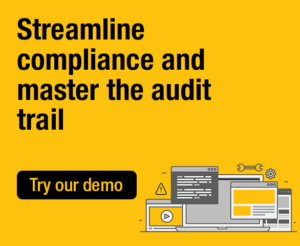 In drug discovery, chemicals must undergo thorough testing before they can be safely administered to the public. It’s critical to prevent the cross-contamination of drug products during the manufacturing process — because even the slightest defect could lead to serious consequences. As a result, manufacturers must comply with both Good Laboratory Practice (GLP) and Good Manufacturing Practice (GMP) regulations to protect consumer safety and ensure preparedness in case of an audit. A Computerized Maintenance Management System (CMMS) software simplifies GMP and GLP compliance.
In drug discovery, chemicals must undergo thorough testing before they can be safely administered to the public. It’s critical to prevent the cross-contamination of drug products during the manufacturing process — because even the slightest defect could lead to serious consequences. As a result, manufacturers must comply with both Good Laboratory Practice (GLP) and Good Manufacturing Practice (GMP) regulations to protect consumer safety and ensure preparedness in case of an audit. A Computerized Maintenance Management System (CMMS) software simplifies GMP and GLP compliance.
What are the OECD principles of GLP?
Good Laboratory Practice, or GLP, governs quality controls throughout the research and development stage by adopting a risk-based approach. The OECD (Organization for Economic Co-operation and Development) principles apply to the research of pharmaceuticals, pesticides, food additives, and cosmetics. The principles assess the health and safety of ingredients containing chemical or biological components.
Here are five key GLP guidelines:
- Organization and Personnel: Includes the responsibilities of the facility manager, study director, and all personnel (such as proposing a study plan, quantifying chemicals, etc.).
- Quality Assurance Programs: Uses a QA system to evaluate observations, methods, and procedures for accuracy to ensure the studies performed are compliant with GLPs.
- Test Facility Recommendations: Separate housing for treating disease, equipment storage, or control articles, to minimize disturbances that interfere with the study.
- Apparatus, Material, and Reagents: Software services used to generate data, clean up testing apparatus, and identify chemical solutions.
- Test and Reference Items: Characterized items are labeled by their date of receipt, date of expiration, and quantity received. Batch records display the number, concentration, and stability.
Examples of On-Site Good Laboratory Practices
Essentially, GLP defines the optimal conditions for conducting non-clinical and environmental studies, with the goal of interpreting collected data to draw a valid conclusion about treatment efficacy against disease.
Some general Good Laboratory Practice (GLP) protocols include:
- Always wearing PPE inside a laboratory when handling biological or chemical reagents
- Communicating deviations in collected results to other technicians to decide on the next steps of testing (success or failure)
- Using the correct lab equipment for each task by following instructions for the setup
- Performing routine maintenance on research processes to pass regulatory audits
- Employing well-trained staff members who are qualified to do their jobs
The purpose of complying with GLP is to guarantee that life science studies produce data that is both reliable and replicable, in order to be accepted by healthcare professionals. It promotes data validity as a method to not only combat fraud, but also to make records traceable.
What are the Fundamentals of GMP Regulations?
Good Manufacturing Practice, or GMP, refers to an organized system for regulating plant production through a series of quality standards. GMP regulations help eliminate many risks associated with the development of pharmaceuticals and how they are labeled for consumption.
These guidelines assure auditors that batches are stored under ideal conditions and are free from contamination, indicating that all steps have been clearly recorded. There are also international Good Manufacturing Practice resources to educate manufacturers operating outside the U.S.
Aside from defining controlled processes, manufacturers are expected to maintain traceable documentation of the batch history up until its distribution to the retail market. Likewise, they should have a recall system to quickly detect and remove mislabeled batches from pharmacy shelves.
Drug companies will have an easier time getting finished products approved by the FDA if they incorporate GMPs into all aspects of quality assurance.
Why GMP Regulations Matter to Manufacturers
GMP regulations play a significant role in the food and beverage industry and the pharmaceutical industry because customers put their trust in companies to deliver safe, reliable goods and services. These standards safeguard against the potential risks of product defects. GMP regulations recommend several cost-efficient measures, from calibrating equipment to replacing depreciated parts.
To pass a GMP audit, companies must follow the guidelines and implement them whenever they need to adjust or manage the systems in place. For example, in areas such as waste management, this can mean cutting down on material losses to minimize expenses.
In addition, facilities should practice good sanitation and hygiene by prioritizing temperature, bacteria, and air circulation monitors. Inventory management is just as important to the production line as tracking where chemicals are transported so that plant managers can predict the number of work orders to fulfill.
GMP certification can help transform a poorly managed plant into a productive operating environment. It also raises awareness of production safety standards among employees during all stages of production. These best practices should be followed across all areas of maintenance and quality management.
How a CMMS Can Improve GMP and GLP Compliance
Regulatory standards tend to be stricter in the food and beverage and pharmaceutical industries. Good Manufacturing Practice principles employ quality checks to determine whether released products are safe to use. A compliance checklist includes items such as the transport of goods, auditing of GMPs, storage of inventory, and accuracy of packaging.
A CMMS software that automates work orders and streamlines the record keeping process for compliance is key. eMaint CMMS does this, providing traceable documentation detailing the types of intervention taken, along with the authorizations necessary to repair or replace equipment. With a CMMS, technicians can make notes or even attach images of procedures. Getting signoffs on the documents that matter is easier when all documentation is centralized. Ultimately, a CMMS helps manufacturers with GMP and GLP compliance.
